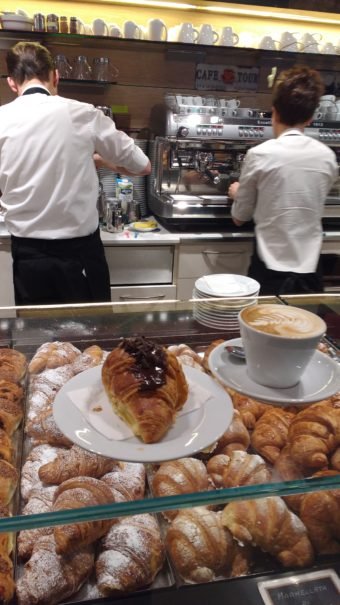
The Serious Business of Breakfast in Northern Italy

The Serious Business of Breakfast in Northern Italy
Cappucino in Brianza
It’s 8:30 a.m. in the northern Italian village, and the café is in full swing. The businessmen and bank managers are there in their suits, having a quick caffè, as they call the espresso round here. They stand at the bar, against its glass cases filled with every type of brioche and croissant. They chat opposite shiny polished coffee machines where smartly uniformed staff prepare caffé, caffé lattes, and marocchino, coffees in chic little glasses.
But the cappuccino is the star of the show. Cappuccino, that unassuming coffee copied all over the world, smooth and light in a simple white cup. (But never order it after 11 a.m.) Cappuccino e brioche is the staple breakfast of northern Italy.
It’s the weekly market day and locals from the village gather in the bar. Old ladies fresh from morning mass in pearls and dark woolen coats sit around one of the tables, women who were once busy with grandchildren, but the grandchildren are grown now. They talk together in a mixture of Italian and local dialect about daughters, grandchildren, people they know. And did you hear about Francesca, what a terrible life she’s had, and now this?
The tables fill up, mostly with women. Women who have come from school drop-offs, women who no longer do the drop-off, women in black coats and black sunglasses with designer handbags. They prefer the longer breakfast, spreading it out until past mid-morning.
It’s mid-morning now, and the staff are clearing away what remains of the brioches and preparing for the pre-lunch aperitivo. A few retired husbands have come to join their wives at the tables, back from a walk through the market and a look around its stalls with the fresh ricottas and salamis brought down from the hillside farms.
Mothers are starting to come in from the market. They queue up at the deli above glass-cased pasticcini, cannoncini—small tarts topped with strawberries, raspberries, kiwi, and grapes—next to sticky, rum-flavored babas. There are biscuits, chocolate, butter, almond, two-tone beige and chocolate swirls, and a tray of pastel-colored macaroons. And then there are the cakes: tarts with jam, tarts with fresh fruit, chocolate cakes, apple cake, various forms of cream cakes, all with fluted edges.
These are the mothers who buy pizza and focaccia and bread for hungry children who will soon be home for lunch from school. These are the mothers who rush around in lives they never quite envisaged, just like their mothers before them. They stop at the bar for a quick caffè, then say goodbye to their friends and go off back into their lives.